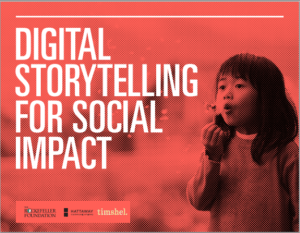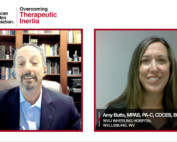Good stories get everyone excited, and we’ve found they’re the basis for creating compelling video and other digital media. And if an organization builds good story collection techniques, they tend to get really good stories.
The Rockefeller Foundation reports on the value of good storytelling in digital media
 We thought the Rockefeller Foundation was dead-on in a recent report, “Digital Storytelling for Social Impact,” when it said about the collection of stories:
We thought the Rockefeller Foundation was dead-on in a recent report, “Digital Storytelling for Social Impact,” when it said about the collection of stories:
[T]he collection piece is where it goes wrong because there often isn’t a strategic approach to collecting stories. There isn’t a lot of intentionality…. [I]f more time goes into collecting stories, you get a better output overall. You also get a better sense of how you want to share the story, and how you want to measure it.
The quoted person, who has experience in branding, went on to say that a platform or software tool that supports the story collection piece would be really valuable. We have to agree; this kind of platform would be a big help to many of our clients as a way of organizing their good stories.
Campaigns are a good way to get good stories
Sometimes it’s hard to take the time to gather and organize story materials into good stories—and to mobilize others to do so. Given this, creating a project focused on gathering stories has great potential to make the time. We’ve seen this work really well for clients who have mobilized their staff and stakeholders in a story-gathering campaign around a significant organizational anniversary, establishing a YouTube donor playlist series, or even a redefinition or rebranding of the organization.
One of our clients, the Mechanical Contracting Education & Research Foundation (MCERF), received a grant from a generous corporate sponsor to launch a campaign to gather good stories from their varied stakeholders. These include contractors, manufacturer-suppliers, local executives of association affiliates across the country, educators who teach mechanical contracting, and students who may have future careers in the business. Once they launched “The MCERF Story” project, good stories began to turn up everywhere, from varied sources. We found good stories of dedicated faculty’s involvement in their students’ successes, family businesses that span multiple generations, and stories that illustrate how all the parts of MCERF function together to attract students to mechanical contracting and launch them on lifelong careers connected with the industry.
Another Story Collection Technique Leading to Good Stories to Tell
In another example highlighted by the blog Getting Attention, the Robert Wood Johnson Foundation undertook a campaign to gather good stories. They focused on their 40th anniversary and soliciting stories through social media and email. This kind of open-ended campaign required some management, but yielded some wonderful stories.
Story Collection Tips
A few story collection tips that apply to open-ended campaigns as well as campaigns like MCERF’s, which had more dedicated resources for collection techniques:

- Always think multimedia—collect written materials and images for print as well as digital use, and make a special effort to collect video footage wherever you can.
- When you gather story material, be specific about what makes good stories for your purpose and your audience, so that any story contributors can be truly helpful.
- Communicate about your timelines for getting material. While it’s tempting to leave everything open ended—to say you’re always accepting good stories—people work better with deadlines and promises of acknowledgement. Also acknowledge receipt of self-submitted stories promptly; it’s just part of working in a digital age.
- Use communication “touch” opportunities to collect stories. For example, when thanking donors, ask why they care so much and you may get good stories.
- Lastly, track your program grads with dedicated resources—these people embody the impact of your organization and mission, and your most relevant stories for donors.
Good stories to tell have enormous impact; donors really respond to them. As Forbes reported recently, the latest research suggests it’s vital that potential donors see beneficiaries as “deserving,” and that means fleshing out their characteristics with information, such as good stories provide. Getting good stories to tell is a core mission of most nonprofit communications efforts these days; done right it has enormous potential.



